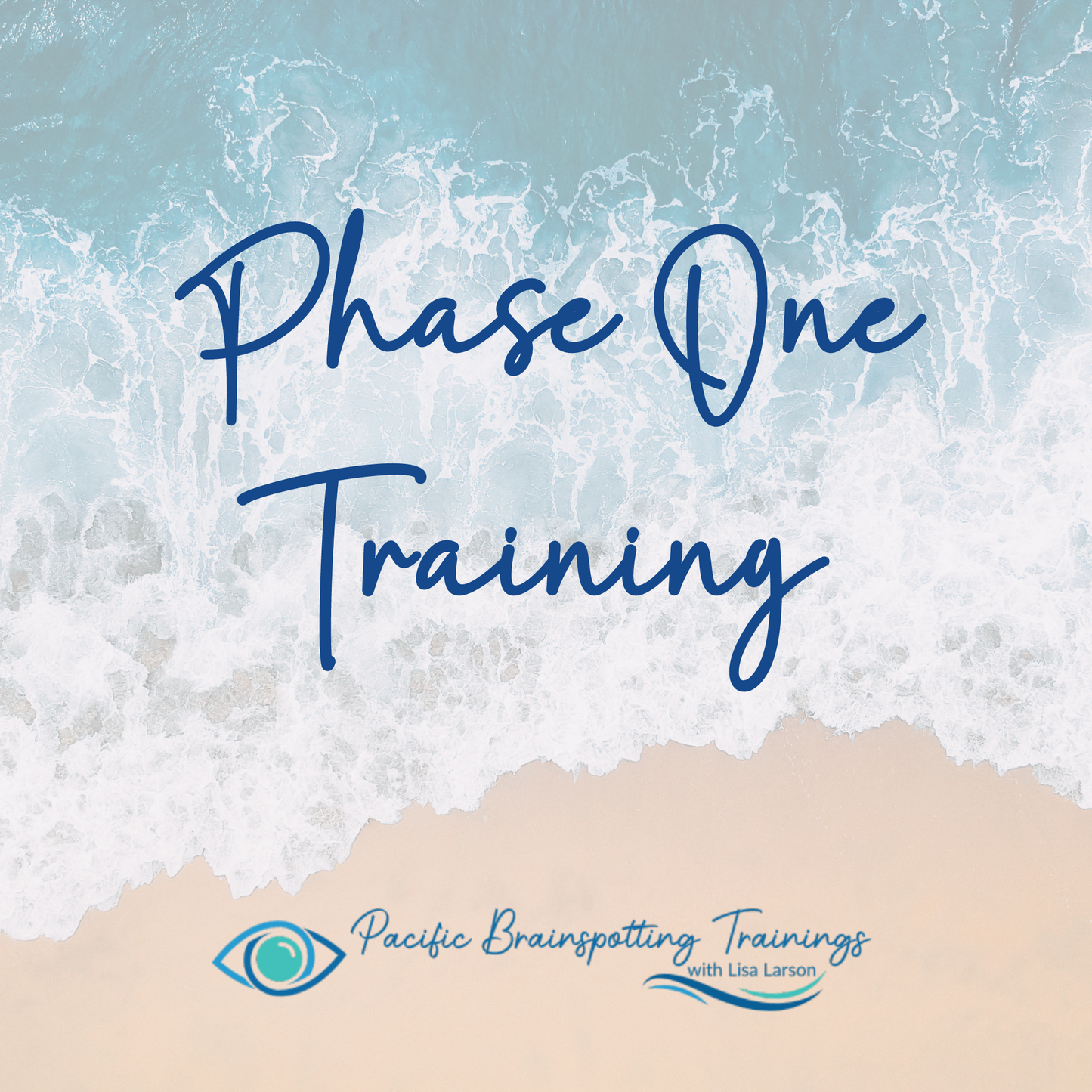BRAINSPOTTING PHASE 1 - JANUARY 2026
BRAINSPOTTING PHASE 1 - JANUARY 2026
The first course in the Brainspotting training series
January 30 - February 1, 2026 from 9am-5:30pm Pacific
This live webinar takes place on Zoom and is fully interactive. Attendees may ask and answer questions throughout the presentation and participate in instructor-led discussions.
See our CE Guide and Terms & Conditions page for more information regarding CE
| Training | Dates available | Pricing |
| Early Registration | Up to 6 weeks before | $745 |
| Standard Registration | Between 6 weeks and 2 weeks before | $795 |
| Late Registration | 2 weeks before | $845 |
| Student Registration | Anytime (With student proof attached) - must be enrolled in a graduate program in a mental health related field (psychology, social work, counseling, marriage and family therapy) and unable to work independently | $400 |
| Associate Registration | Anytime (With assosiation attached) | $100 off Early/Standard/Late |
| Retake Registration | Anytime (With previous training details provided) | $400 |
PLEASE NOTE: If you are registering two or more attendees for the same training, please add all party's names, emails, phone numbers, and license types. Otherwise, registration will be incomplete!
Couldn't load pickup availability

What is Phase One?
About the course
Brainspotting Phase One introduces students to the theory, research, and best practices of Brainspotting, how it works to heal trauma and other mental health conditions, education on the importance of reaching the deepest regions of the brain in order to have resolution, and the four techniques or ‘frames’ used to engage clients via a specific eye position, or “Brainspot,” so that they can process their trauma and be relieved of other diagnoses and mental health issues.
Educational Goals
After taking part in this course, participants will have greater clinical skills to successfully alleviate the suffering of their clients who are coping with the various trauma responses (Flight, Fight, Freeze, Fawn) from past trauma.
Attendees will learn how to utilize Brainspotting to heal a myriad of mental health conditions effectively, while always following their clients’ lead, as they process, assuring that participants won’t exert undue influence with their own values, beliefs, or identities that may adversely impact the clients’ therapeutic process. They will go back to their practices with greater sophistication in alleviating the symptoms of unresolved traumatic stress such as anxiety, depression, panic, insomnia, rage, hypervigilance, recurring nightmares, dissociation and chronic fatigue. This course will allow them to follow the ethics of staying current with developments in their field through educational activities or clinical experiences.
Participants will grow professionally in their proficiency in appropriately resourcing their clients who may move out of their window of tolerance during the session, or for clients who are especially fragile or poorly resourced in life. This includes increasing their competency in recognizing clients with DID and the goals of treatment for this population. Attendees will be able to assess and appropriately treat those clients experiencing flashback during a session. Participants will move forward with the knowledge that they are working within their scope of practice and competence in treating clients with the goal of reducing their disturbance levels on a scale of 0 to 10 in each session and throughout the therapeutic process.
Learning Objectives
Learning Objectives - Day 1
- Identify the two regions of the brain most involved in regulating a dysregulated nervous system.
- Name three symptoms of being “Stuck On” (Overly Sympathetic in the Autonomic Nervous System).
- Explain the difference between activated eye positions (“Brainspots”) and resource eye positions (“Brainspots”).
- Recognize the two times during a Brainspotting session to identify clients’ subjective units of disturbance (0–10).
- Identify strategies to prevent undue influence on the process and treatment of clients by recalling the two core principles of Brainspotting.
- Demonstrate the eight steps of
the Brainspotting Outside Window technique and apply their knowledge in a practicum setting as both the therapist and the client. - Name three symptoms of being
“Stuck Off” (Overly Parasympathetic in The Autonomic Nervous System).
Learning Objectives - Day 2
- Demonstrate the nine steps of the Brainspotting Inside Window technique and apply their knowledge in a practicum setting as both the therapist and the client.
- Demonstrate the nine steps of
the Brainspotting “Gazespotting” technique and apply their knowledge in a practicum setting as both the therapist and the client. - Explain the importance of
client-therapist attunement during Brainspotting. - Explain the role of focused mindfulness in Brainspotting.
- Apply bilateral music
and describe its primary effect during Brainspotting.
Learning Objectives - Day 3
- List the four most
common types of limbic countertransference that may happen while being exposed to client traumatic material. - Distinguish two differences
between a client in a flashback versus one outside their window of tolerance. - Apply the “Eye Contact”
Brainspot technique until the lashback has passed. - Describe the two symptoms
indicating a client is in flashback. - Recognize the two requirements
to stay within their scope of practice and competence in treating clients with Dissociative Identity Disorder. - Demonstrate the nine steps of the Body Resource technique for fragile or dissociative clients and apply their knowledge in a practicum setting as both therapist and client.
Schedule
DAY 1 AGENDA
9:00–9:15 am: Training Overview and EDI Statement - Apply Brainspotting in an inclusive, diverse, and equitable manner. Overview of class and review of learning objectives.
9:15–9:30 am: “Where You Look Affects How You Feel” (Experiential) - Demonstrate how different eye positions affect emotional and somatic experiences. Identify how the retina, as part of the CNS, influences somatic and emotional responses. Apply techniques to help clients choose the eye position that fits their window of tolerance.
9:30–10:45 am: PowerPoint – Introduction to Brainspotting - Describe the history and research supporting Brainspotting as an evidence-based practice. Explain the neuroscience behind Brainspotting’s effects on the Autonomic Nervous System. Identify the four techniques that will be taught during the course. Describe symptoms of unresolved trauma and how Brainspotting shifts the nervous system from dysregulation to regulation.
10:45–11:00 am: Break
11:00–11:30 am: PowerPoint – Trauma Storage and Basic Steps - Demonstrate the Basic 8 Steps of Brainspotting. Explain the ethical and clinical importance of letting the client lead the process. Identify strategies to stay mindfully attuned and keep clients within their window of tolerance.
11:30–12:15 pm: Demonstration – Outside Window - Demonstrate how to find relevant eye positions outside the client’s conscious awareness. Explain the use of this technique for clients who are dissociating.
12:15–12:45 pm: Debrief and Q&A - Describe how to utilize the Outside Window technique effectively for dissociation.
12:45–1:45 pm: Lunch
1:45–2:00 pm: PowerPoint Review – Outside Window Preparation - Review the eight steps in preparation for practicum.
2:00–3:30 pm: Outside Window Practicum - Apply the Outside Window technique as both therapist and client in a guided practicum.
3:30–4:00 pm: Debrief & Q&A - Explain experiences and clarify steps to ensure participants feel confident using this technique with clients.
4:00–4:15 pm: Break
4:15–5:00 pm: Demonstration – Inside Window - Demonstrate the nine steps of the Inside Window technique. Show how to have clients choose their preferred level of intensity.
5:00–5:30 pm: Debrief & Q&A - Describe how to implement the Inside Window technique effectively.
DAY 2 AGENDA
9:00–9:15: Check in, review of previous day - Describe learning from day one and explain observations from volunteer demonstrations.
9:15–9:30: Review PowerPoint – Inside Window - Describe the nine steps of the Inside Window technique.
9:30–11:00: Inside Window Practicum - Apply the Inside Window technique as both client and therapist.
11:00–11:15: Debrief & Q&A - Explain the Inside Window technique experience and key points.
11:15–11:30: Break
11:30–12:15: Demonstration – Gazespotting - Demonstrate how to identify naturally occurring gaze positions and explain how to assess disturbance levels.
12:15–12:45: Debrief & Q&A - Describe how to apply the Gazespotting technique.
12:45–1:45: Lunch
1:45–2:00: Review PowerPoint – Gazespotting - Describe any remaining questions about Gazespotting prior to practicum.
2:00–3:30: Gazespotting Practicum - Apply the Gazespotting technique as both client and therapist.
3:30–4:00: Debrief & Q&A - Explain the Gazespotting technique experience and key points.
4:00–4:15: Break
4:15–5:00: Small Group Q&A Breakouts - Describe applications of Brainspotting techniques with various populations and conditions.
5:00–5:30: Large Group Q&A - Explain any remaining theory, techniques, or clinical applications.
DAY 3 AGENDA
9:00–9:15: Check in, review of previous day - Describe comprehension from the previous day’s teaching.
9:15–10:45: PowerPoint – Brainspotting Resource Model - Describe the Brainspotting Resource Model and its applications.
10:45–11:00: Break
11:00–11:30: PowerPoint – Brainspotting for DID - Describe the six goals of treatment for clients with Dissociative Identity Disorder and scope requirements.
11:30–12:15: Demonstration – Body Resource Model - Demonstrate the Body Resource technique for fragile clients.
12:15–12:45: Debrief & Q&A - Describe the Body Resource technique and its applications.
12:45–1:45: Lunch
1:45–2:00: Review PowerPoint – Body Resource Model - Describe the nine steps of the Body Resource technique.
2:00–3:30: Body Resource Practicum - Apply the Body Resource technique as both therapist and client.
3:30–4:00: Debrief & Q&A - Explain the Body Resource technique experience and key points.
4:00–4:15: Break
4:15–5:00: Small Group Q&A / Using BSP with various populations - Describe applications of Brainspotting techniques with various populations and clinical conditions.
5:00–5:30: Final Q&A, Closing - Explain any remaining questions or clinical applications.


